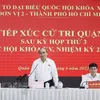Seafood enterprises await growth opportunities

However, analysts expected that the negative impacts are only temporary and opportunities for seafood processing and exporting enterprises are huge.
Growth momentum KIS Securities Corporation (Vietnam) said that stable global seafood demand provides growth momentum for Vietnamese seafood processing and exporting enterprises.
According to the Food and Agriculture Organisation of the United Nations (FAO), the global fish supply will increase by 32 percent in 2011-2030 to 204 million tonnes, equivalent to a compound annual growth rate (CAGR) of 2.3 percent. By 2030, fish catches will be limited, and will be replaced by farmed fish instead, the organisation added.
Thereby, it is forecast that aquaculture output will reach 109 million tonnes, up 32 percent compared to 2018, when the catches will be 95 million tonnes, equivalent to that of 2018. Key products boosting the growth rate are tilapia, carp, tra and shrimp.
The World Bank said that with global population and global GDP up by 20.2 percent and 17.4 percent, respectively, in 2010-2030, average fish consumption is likely to climb. Annual fish consumption per capita is expected to rise from 17.2kg to 18.2kg during the period. Realising the growth potential of seafood consumption, the Government wishes to maintain its leading position in the strategic development plan until 2030.
Accordingly, Vietnamese seafood output is expected to reach 9.8 million tonnes, including 7 million tonnes of aquaculture production and 2.8 million tonnes of catches. The growth target of 14 billion USD by 2030 is much higher than that of 2021, which was 8.9 billion USD.
Since 2021, the Prime Minister issued Decision 1408/QD-TTg approving the development of the seafood processing industry for the next ten years. In particular, to form a number of modern seafood processing corporations and enterprises, and to deeply integrate into the global value chain with a world-class management level.
The sustainability of supplies will be higher thanks to competitive shrimp farming facilities and techniques. “This is the golden time for the Government to shift focus to a value-oriented approach by enhancing the value of each product,” said experts from KIS Vietnam.
The securities firm added that the free trade agreements (FTA) also create a strong growth driver for the seafood industry. By 2020, Vietnam had 14 FTAs in effect, providing enormous opportunities to boost export turnover and offer more competitive products. KIS Vietnam believes that the advantages of tariff reductions will help increase the competitiveness of Vietnamese seafood products in overseas markets.
Maximising tax advantages from FTAs, the Government is expanding new generation FTAs such as the Regional Comprehensive Economic Partnership (RCEP), the EU-Vietnam Free Trade Agreement (EVFTA) and UK-Vietnam Free Trade Agreement (UKVFTA). The FTAs will certainly open new and large consumption markets for Vietnamese seafood exports, contributing to improving the competitiveness of the industry.
Challenges remain The seafood industry has great opportunities, but KIS Vietnam believes that there are still risks that businesses in this industry must face. Fuel prices have soared since the conflict between Russia-Ukraine began at the end of February.
Raw material prices in 2022 will advance by 50 percent over last year, said KIS Vietnam. This will cause transportation costs to edge up or remain at high levels, which can hurt exporters with products shipped by CIF.
For shrimp exporters, high freight rates will not be included in the average selling price, as the average selling price of shrimp is already higher than that of competitors such as Ecuador, India and Indonesia. In addition, there is compliance with regulations against IUU fishing. Four years since receiving the "yellow card", Vietnamese seafood export volume to the EU market declined by 3 percent during 2017-2021.
In 2022, the Government will come up with appropriate and effective solutions to quickly solve the "yellow card" penalty. Vietnam, then, can avoid the risk of receiving a "red card" and enjoy preferential tariffs and institutional changes from the EVFTA.
However, if there is no improvement in the implementation of the recommendations, the European Commission (EC) is unlikely to remove the "yellow card" for Vietnamese seafood. The worst-case scenario is that Vietnam may be judged as non-cooperative and will be subject to a "red card." This means the country’s seafood will be banned from being exported to the EU, causing a loss of nearly 500 million USD per year, according to estimates from the Vietnamese authorities.
At that time, not only the EU but other markets can also apply similar measures to Vietnamese seafood. Big returns in Q1 Even though there are many risks and difficulties, especially rising fuel prices, seafood enterprises still recorded strong growth in profit in the last quarter.
Vinh Hoan Corporation (VHC) posted a profit after tax of 550 billion VND in the first quarter of 2022, 4.2 times higher than that of the same period last year, according to its quarterly financial statement. This is its highest quarterly profit since the third quarter of 2018. In April, the company said that its revenue jumped 98 percent year-on-year and 20 percent compared to the previous month.
For the first four months, pangasius enterprises reported total revenue of over 4.9 trillion VND, up 88 percent over last year. Meanwhile, I.D.I International Development & Investment Corporation (IDI) saw a record quarterly profit in the last quarter, with a profit after tax of 200 billion VND. Navico (ANV) also announced a profit before tax of 238 billion VND, up 3.2 times over the same period last year. Despite the sky-rocketing freight rates, Navico still sets a target of 4.9 trillion VND in revenue this year, a gain of 40 percent, and 720 billion VND in profit before tax, 4.8 times higher than in 2021.
Mirae Asset Securities (Vietnam) expect seafood enterprises to achieve outstanding business results in 2022, with extraordinary corporate revenues and profit in the second quarter. However, it noted that the trend will gradually fade in the remaining two quarters as 2021's low-priced inventory has been depleted and the new harvest with higher costs will start at the end of the third quarter of 2022.





